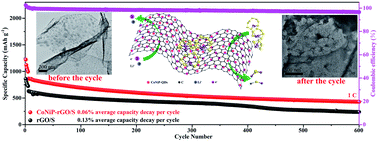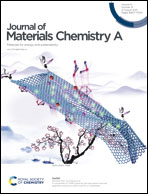A composite of CoNiP quantum dot-decorated reduced graphene oxide as a sulfur host for Li–S batteries†
Abstract
The “shuttle effect” and sluggish reaction kinetics of lithium polysulfides lead to inferior cycling performance and rate capability of Li–S batteries, which impede their practical application. Herein, a composite of CoNiP quantum dot-decorated graphene oxide (CoNiP-rGO) was designed and prepared and used as a sulfur host in Li–S batteries. SEM and TEM images show that countless CoNiP quantum dots (CoNiP-QDs) are uniformly dispersed on the rGO nanosheets. Density functional theory (DFT) calculations certify the metallic property and high activity of the CoNiP-QDs. At the same time, the rGO enhances the electronic conductivity of the electrode and ensures uniform dispersion of the CoNiP-QDs. Benefitting from the CoNiP-QDs and rGO, compared with the CoP or NiP sulfur hosts reported in the literature, the CoNiP-rGO host demonstrates obvious advantages in specific capacity and cycle stability. The Li–S battery with the CoNiP-rGO/S cathode demonstrates a high capacity of 598.2 mA h g−1 at 3C rate. At the same time, it delivers excellent cycle-performance with a capacity decay rate of 0.08% after 600 cycles at 1C rate. This work provides a simple and universally applicable method for manufacturing metal phosphide quantum dot/rGO as a sulfur host for Li–S batteries.

- This article is part of the themed collection: Journal of Materials Chemistry A HOT Papers


 Please wait while we load your content...
Please wait while we load your content...